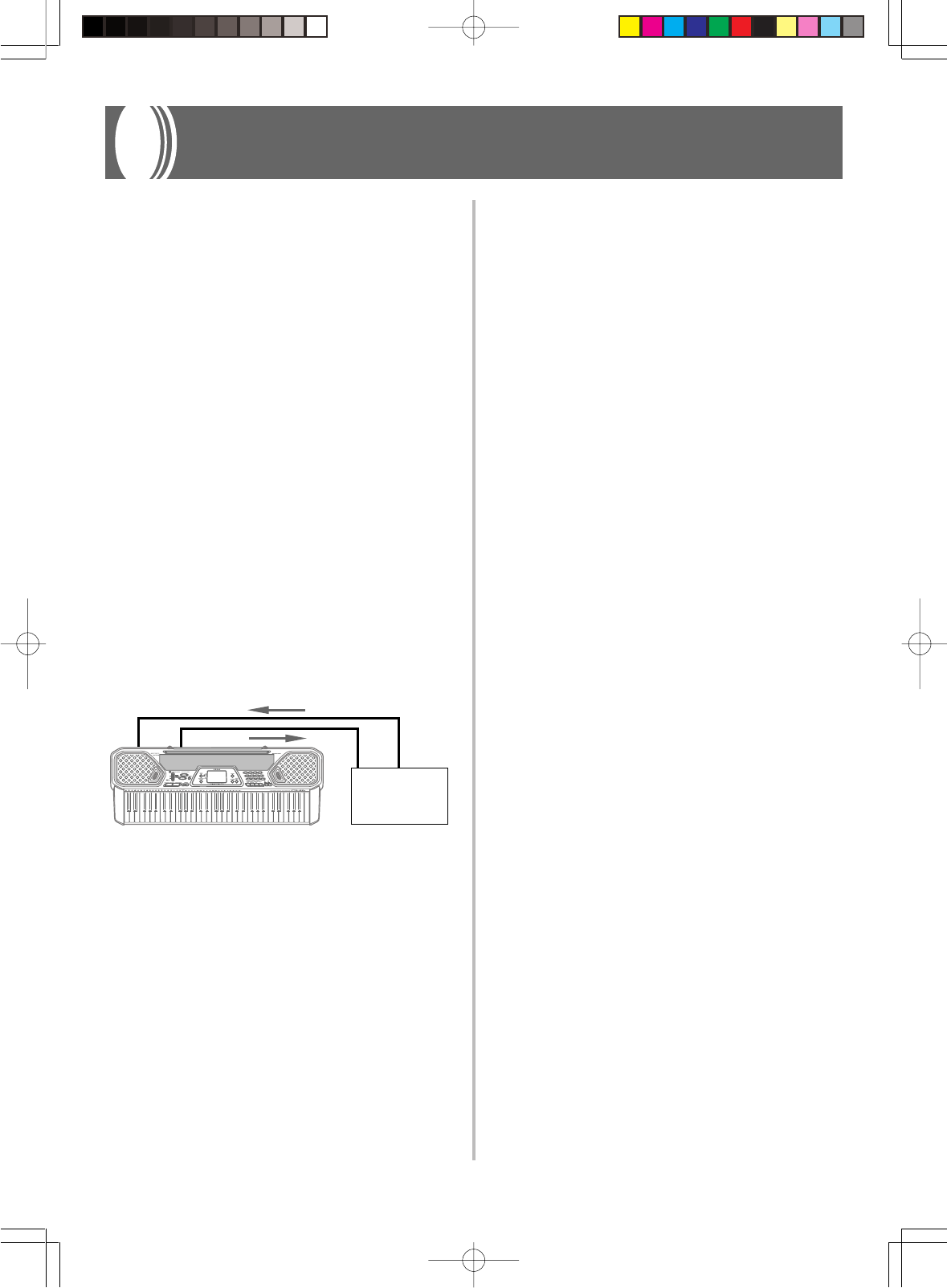
E-31
MIDI
What is MIDI?
The letters MIDI stand for Musical Instrument Digital Inter-
face, which is the name of a worldwide standard for digital
signals and connectors that makes it possible to exchange
musical data between musical instruments and computers
(machines) produced by different manufacturers. MIDI com-
patible equipment can exchange keyboard key press, key re-
lease, tone change, and other data as messages.
Though you do not need any special knowledge about MIDI
to use this keyboard as a stand-alone unit, MIDI operations
require a bit of specialized knowledge. This section provides
you with an overview of MIDI that will help to get you go-
ing.
MIDI Connections
MIDI messages are send out through the MIDI OUT termi-
nal of one machine to the MIDI IN terminal of another ma-
chine over a MIDI cable. To send a message from this key-
board to another machine, for example, you must use a MIDI
cable to connect the MIDI OUT terminal of this keyboard to
the MIDI IN terminal of the other machine. To send MIDI
messages back to this keyboard, you need to use a MIDI ca-
ble to connect the other machine’s MIDI OUT terminal to the
MIDI IN terminal of this keyboard.
To use a computer or other MIDI device to record and play-
back the MIDI data produced by this keyboard, you must
connect the MIDI IN and MIDI OUT terminals of both ma-
chines in order to send and receive data.
MIDI Channels
MIDI allows you to send the data for multiple parts at the
same time, with each part being sent over a separate MIDI
channel. There are 16 MIDI channels, numbered 1 through
16, and MIDI channel data is always included whenever you
exchange data (key press etc.).
Both the sending machine and the receiving machine must
be set to the same channel for the receiving unit to correctly
receive and play data. If the receiving machine is set to Chan-
nel 2, for example, it receives only MIDI Channel 2 data, and
all other channels are ignored.
With this keyboard, messages received over MIDI Channels
1, 2, 3, 4, and 10 can be used for multi-timbre play of up to
five different instrument parts. The tone and volume settings
for these five channels must be controlled by messages sent
from an external device.
When sending operation of this keyboard to an external de-
vice, Channel 1 should be selected as the MIDI send channel.
General MIDI
General MIDI standardizes MIDI data for all sound source
types, regardless of manufacturer. General MIDI specifies
such factors as tone numbering, drum sounds, and available
MIDI channels for all sound sources. This standard makes it
possible for all MIDI equipment to reproduce the same nu-
ances when playing General MIDI data, regardless of the
manufacturer of the sound source.
Though the sound source of this keyboard is not General
MIDI compatible, you can still connect the keyboard to a com-
puter or other MIDI equipment to playback General MIDI
data that is widely available in stores, over computer net-
works, and from other sources.
❚
NOTE
• General MIDI data made up of a large number of parts may not
play correctly on this keyboard.
• You will have most success playing back General MIDI data
that has few parts and is made up of data on channels 1, 2, 3,
4, and 10.
Messages
There is a wide variety of messages defined under the MIDI
standard, and this section details the particular messages that
can be sent and received by this keyboard.
NOTE ON/OFF
This message sends data when a key is pressed (NOTE ON)
or released (NOTE OFF).
A NOTE ON/OFF message include a note number (to indi-
cate note whose key is being pressed or released) and veloc-
ity (keyboard pressure as a value from 1 to 127).
NOTE ON velocity is always used to determine the relative
volume of the note. This keyboard does not receive NOTE
OFF velocity data.
Whenever you press or release a key on this keyboard, the
corresponding NOTE ON or NOTE OFF message is sent by
constant velocity from the MIDI OUT terminal.
❚
NOTE
• The pitch of a note depends on the tone that is being used, as
shown in the Note Table on page A-2. Whenever this keyboard
receives a note number that is outside its range for that tone,
the same tone in the nearest available octave is substituted.
625A-E-033A
MIDI sequencer
MIDI IN MIDI OUT
MIDI IN MIDI OUT
CTK481_E31_33.p65 03.10.7, 2:58 PMPage 31 Adobe PageMaker 6.5J/PPC


















